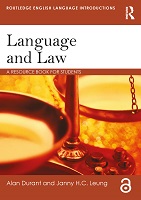Language and Law
Proposal review
A resource book for students
Abstract
Language plays an essential role both in creating law and in governing its implementation. Providing an accessible and comprehensive introduction to this subject, Language and Law:describes the different registers and genres that make up spoken and written legal language and how they develop over time; analyses real-life examples drawn from court cases from different parts of the world, illustrating the varieties of English used in the courtroom by speakers occupying different roles; addresses the challenges presented to our notions of law and regulation by online communication; discusses the complex role of translation in bilingual and multilingual jurisdictions, including Hong Kong and Canada; and provides readings from key scholars in the discipline, including Lawrence Solan, Peter Goodrich, Marianne Constable, David Mellinkoff, and Chris Heffer. With a wide range of activities throughout, this accessible textbook is essential reading for anyone studying language and law or forensic linguistics.
Keywords
English for law; English for specific purposes law; forensic linguistics; language and the law; legal English; legal genres; TextbookDOI
10.4324/9781315436258ISBN
9781315436258Publisher
Taylor & FrancisPublisher website
https://taylorandfrancis.com/Publication date and place
2017Imprint
RoutledgeClassification
Language: reference & general
Law
Language: reference and general
Law
Pages
256Chapters in this book
- Chapter A1 ‘Legal Language’ as a Linguistic Variety
- Chapter A2 Historical Development of Legal English
- Chapter A3 Legal Genres
- Chapter A4 Participant Roles and Speech Styles
- Chapter A5 Persuasion in Court
- Chapter A6 Interpreting Legislative Texts
- Chapter A7 The Vocabulary of Legal Power
- Chapter A8 Regulation of Language Use
- Chapter A9 Forensic Evidence
- Chapter A10 Legal Order and Linguistic Diversity
- Chapter B1 Linguistic Features of Legal Language
- Chapter B2 Functions of Legal Language
- Chapter B3 Genre Analysis of Legal Discourse
- Chapter B4 Speech in the Courtroom
- Chapter B5 Linguistic Strategies Used by Lawyers
- Chapter B6 Pragmatics and Legal Interpretation
- Chapter B7 Legal Speech Acts
- Chapter B8 Disputing ‘Ordinary Language’
- Chapter B9 Techniques in Forensic Linguistics
- Chapter B10 Bilingual and Multilingual Legal Systems
- Chapter C1 Perception of Legal Language
- Chapter C2 Reforming Legal Language
- Chapter C3 Reading a Statute
- Chapter C4 Restricted Verbal Interaction in Court
- Chapter C5 Techniques in Legal Advocacy
- Chapter C6 Deciding Legal Meaning
- Chapter C7 Spoken and Written Performatives
- Chapter C8 Misleading Language in Adverts
- Chapter C9 Language Data as Evidence
- Chapter C10 Same Law, Different Texts

